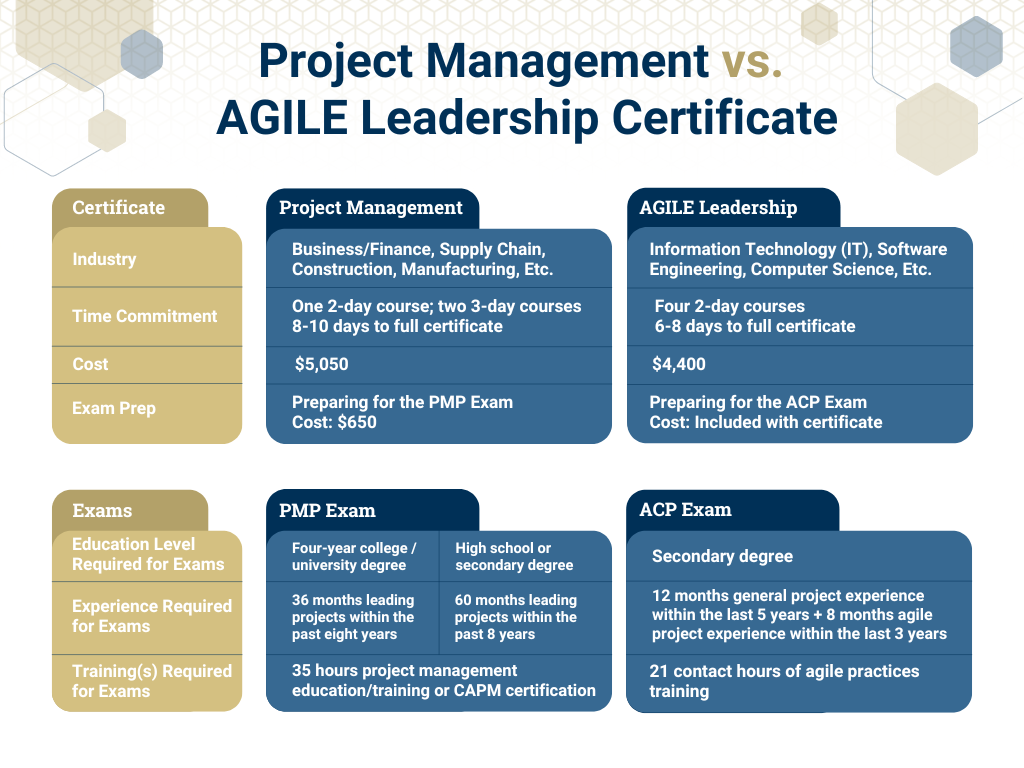The Benefits of AGILE
AGILE is an innovative project management methodology that champions adaptability, iteration, and collaborative efforts and is applicable in any environment that attempts to satisfy stakeholders.

As technology advances and capabilities climb, projects and solutions are growing more complex. To get things done, organizations are relying increasingly on the human skills of management, collaboration, and adaptability – the skillset of an Agile project manager.
WHAT IS AGILE PROJECT MANAGEMENT?
According to the Project Management Institute (PMI), “Project management is the application of knowledge, skills, tools, and techniques to project activities to meet project requirements. It’s the practice of planning, organizing, and executing the tasks needed to turn a brilliant idea into a tangible product, service, or deliverable.” This skillset is needed in every organization that aims to deliver something for its stakeholders and can be applied in nearly every industry across a variety of environments, scopes, and needs.
Agile is a specific approach to project management. Like its name suggests, it is flexible and iterative, emphasizing collaboration and continuous improvement over the course of several iterations, which makes it highly attractive to companies looking to provide more adaptable solutions for their customers.
The Agile methodology breaks down a project into a series of short cyclical phases, incorporating customer feedback at the end of each one. This real-time data allows teams to adjust to changing needs, desires, and circumstances along the project timeline.

5 BENEFITS OF AGILE PROJECT MANAGEMENT
As a modern project management approach, Agile helps organizations deliver value quickly — especially in software development projects and other complex projects. No matter if you’re building apps, launching services, or coordinating cross-functional work, below are some key advantages of Agile methodology that teams may experience:
1. Adaptability and Flexibility
Agile teams can respond to changes without derailing a project because planning happens in short, time-boxed iterations that align with the project life cycle. Work is prioritized in a living backlog, so when requirements shift or process changes emerge, team members can re-order the next sprint and keep momentum — something that’s harder in traditional project management. This agile development rhythm makes it easy to adjust the development process mid-stream: refine scope, revise product descriptions, or revisit acceptance criteria while protecting delivery obligations. The result is an iterative approach that bends without breaking and keeps work flowing toward the final product.
2. Higher Quality Outcomes
Frequent feedback loops ensure better deliverables. In Agile software development, each sprint ends with a potentially releasable (or “shippable”) increment that’s reviewed against clear acceptance criteria; this helps tighten quality control early and often. Paired with best practices like peer reviews, automated tests, and continuous integration, the development team surfaces defects sooner and aligns solutions with real user needs. This reduces last-minute surprises at release time and improves the final product across both software development and non-technical work.
3. Greater Customer Satisfaction
Agile incorporates user input every sprint, keeping stakeholders happy and engaged. Regular demos, usability checks, and stakeholder reviews invite fast, actionable feedback, so teams can validate assumptions and course-correct before small issues become big ones. By iterating on an Agile model and embracing iterative development rather than major, drastic releases, team members deliver incremental value that customers can see and use. This steady cadence builds trust and satisfaction across products and services, from internal tools to public-facing software development projects.
4. Continuous Improvement
Agile teams learn and grow stronger with each iteration. Specifically, sprint retrospectives create a structured space to reflect on what worked and what didn’t, as well as what to try next. Running small experiments like tweaking estimation, reducing handoffs, or streamlining code reviews, teams steadily improve flow and throughput across the development process and throughout the project life cycle. This habit of continuous improvement also accelerates Agile adoption, as each cycle clarifies best practices the team wants to carry into future work.
5. Career Advancement
Agile skills signal that you can lead collaborative work, navigate ambiguity, and deliver results across industries. From PMI’s Agile Certified Practitioner (ACP) to courses in the scaled Agile framework, earning credentials in Agile development methodology could open doors to leadership roles on larger teams and complex initiatives. In fact, PMI reports that 86% of these certified professionals qualified for new opportunities.
Understanding both the strengths and the disadvantages of Agile development (for example, when more structure from traditional project management might be appropriate) makes you a more versatile practitioner. As organizations mature in their Agile adoption, professionals who can articulate the benefits of agile methodology, apply the right best practices, and guide teams through change are well-positioned to earn new opportunities while championing the benefits of Agile development.

WHAT IF I DON’T HAVE EXPERIENCE IN
PROJECT MANAGEMENT?
If you’re just getting started in the project management field, earning your Agile Certified Practitioner (ACP) credential is a great place to start.
“I would do the ACP first, and then go for the PMP,” says Joe Sisto, Project Management and AGILE Leadership instructor at Georgia Tech. “The PMP is far more difficult; it’s a much harder exam requiring a lot more test prep and class work.”
The ACP exam requires less preparation than the PMP exam, with only 120 questions compared to 180 questions on the PMP. Furthermore, the PMP requires more demonstrated work experience as compared to the ACP.
PREPARE FOR THE ACP EXAM
While both exams require you to complete a certain number of educational hours to qualify, you can complete the required hours for the ACP by enrolling in the Georgia Tech AGILE Leadership Certificate offered through Georgia Tech Professional Education (GTPE).
“The Georgia Tech AGILE Leadership Certificate will provide you with the ability to work with projects using the Agile Framework,” Sisto says. “Our combination of classroom learning, exercises, and real-world instruction will give you the means to apply your knowledge at work.”
FURTHER YOUR PROJECT MANAGEMENT SKILLS WITH GEORGIA TECH
Over a series of four strategic courses taught by experienced ACPs, the Georgia Tech AGILE Leadership Certificate provides the foundation for the Agile skillset and prepares students to ace their ACP exams. Course topics include Practicing Agile, Advanced SCRUM Workshop, Agile Project Management, and Preparing for the ACP Exam.
Throughout the course curriculum, you’ll master the four values and twelve principles of the AGILE Manifesto, gain essential program management practices that align to Agile principles and values, and integrate an Agile team mindset and structure that enables value delivery.
Visit the AGILE Leadership Certificate page to learn more.
Credits
Writer: Rachel Meyer
Editor: Kelly Pierce
Digital Publisher: Kat Bell

